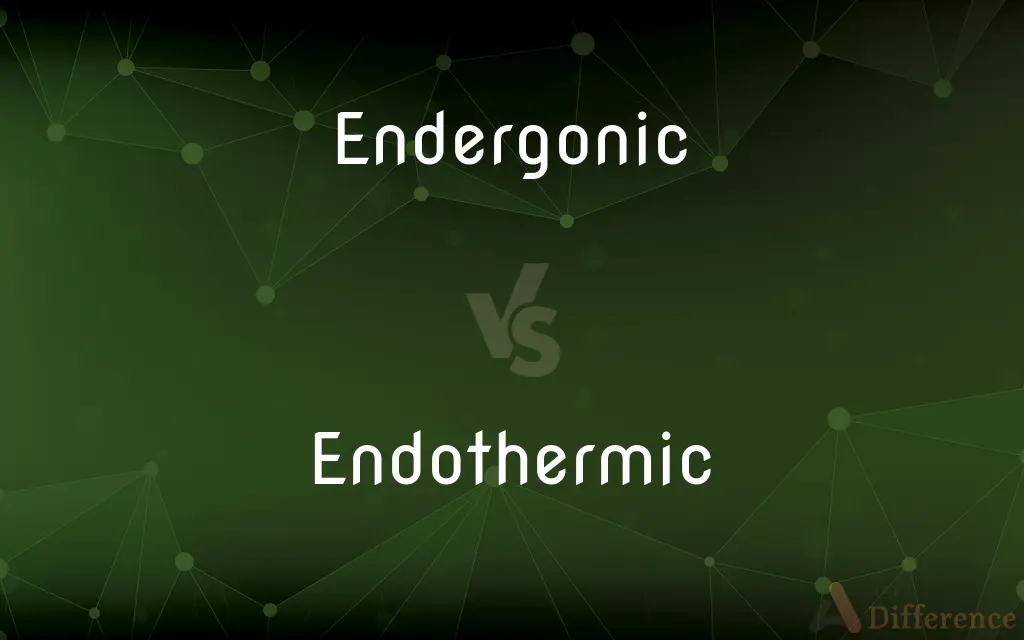Endergonic vs. Endothermic — What's the Difference?
Edited by Tayyaba Rehman — By Urooj Arif — Updated on April 20, 2024
Endergonic reactions absorb energy from their surroundings, while endothermic processes specifically absorb heat.

Difference Between Endergonic and Endothermic
Table of Contents
ADVERTISEMENT
Key Differences
Endergonic reactions are characterized by their requirement for energy input, leading to a net absorption of energy to drive the reaction forward. On the other hand, endothermic processes specifically focus on the absorption of heat energy, a subset of the broader category of energy types that endergonic reactions might utilize.
While endergonic reactions are defined by a positive change in Gibbs free energy (ΔG > 0), indicating non-spontaneity under constant temperature and pressure, endothermic reactions are defined by a positive change in enthalpy (ΔH > 0), signifying heat absorption regardless of the Gibbs free energy change.
Endergonic reactions are not inherently tied to temperature changes but are more about the energy dynamics within a chemical system. In contrast, endothermic reactions always result in a temperature decrease of the surroundings due to the absorption of heat.
In biological systems, endergonic reactions are crucial as they often couple with exergonic reactions (which release energy) to facilitate essential biological functions. Whereas, endothermic reactions are typically discussed in the context of physical sciences, particularly thermodynamics and chemistry.
Endergonic reactions can occur in both chemical and physical processes where energy is required, whereas endothermic reactions are primarily associated with specific chemical reactions or phase changes, such as melting or vaporization.
ADVERTISEMENT
Comparison Chart
Energy Change
Absorbs any form of energy
Specifically absorbs heat energy
Thermodynamic Property
Positive Gibbs free energy (ΔG > 0)
Positive change in enthalpy (ΔH > 0)
Spontaneity
Non-spontaneous
Can be spontaneous or non-spontaneous
Temperature Effect
May not affect temperature
Typically decreases surrounding temperature
Common Occurrences
Many biochemical processes
Chemical reactions, phase changes
Compare with Definitions
Endergonic
A reaction requiring energy to proceed.
Photosynthesis is an endergonic reaction where light energy is absorbed.
Endothermic
Not necessarily non-spontaneous.
The dissolution of ammonium nitrate in water is endothermic yet spontaneous.
Endergonic
Characterized by energy absorption from the surroundings.
The synthesis of glucose from carbon dioxide is endergonic.
Endothermic
A process that absorbs heat from its surroundings.
The melting of ice is an endothermic process.
Endergonic
Non-spontaneous under standard conditions.
The conversion of ADP to ATP is an endergonic process in cells.
Endothermic
Results in a decrease in the temperature of the surroundings.
Evaporation of water is endothermic, cooling the environment.
Endergonic
Often coupled with exergonic reactions in biological systems.
Muscle contraction is driven by endergonic reactions using ATP.
Endothermic
Common in phase changes and chemical reactions.
The sublimation of dry ice into carbon dioxide gas is an endothermic change.
Endergonic
Involves an increase in Gibbs free energy.
Electrolysis of water is an endergonic reaction.
Endothermic
Associated with a positive enthalpy change.
The reaction of barium hydroxide octahydrate with dry ammonium chloride is endothermic.
Endergonic
Requiring energy
An endergonic chemical reaction.
Endothermic
(Chemistry) Characterized by or causing the absorption of heat; endoergic.
Endergonic
(chemistry) Describing a reaction that absorbs (heat) energy from its environment
Endothermic
(chemistry) Of a chemical reaction that absorbs heat energy from its surroundings.
Endothermic
(zoology) Of an animal whose body temperature is regulated by internal factors.
Endothermic
Designating, or pert. to, a reaction which occurs with absorption of heat; formed by such a reaction; as, an endothermic substance; - opposed to exothermic.
Endothermic
(of a chemical reaction or compound) occurring or formed with absorption of heat
Common Curiosities
Why are endothermic reactions important in chemistry?
They help in understanding energy changes during chemical reactions and phase changes.
Can a reaction be both endergonic and endothermic?
Yes, a reaction can be both if it absorbs heat and requires additional energy input to proceed.
Are all endergonic reactions also endothermic?
Not all; endergonic reactions may absorb forms of energy other than heat.
What is the main difference between endergonic and endothermic?
Endergonic reactions require any form of energy input, while endothermic specifically involves heat absorption.
What signifies a reaction is endergonic?
A positive change in Gibbs free energy (ΔG > 0).
What signifies a process is endothermic?
A positive change in enthalpy (ΔH > 0).
How do endergonic reactions occur in living organisms?
Through the coupling with exergonic reactions that release energy, like cellular respiration.
Can endothermic processes occur spontaneously?
Yes, if the entropy increase sufficiently compensates for the heat absorption, making ΔG negative.
What is an example of an endergonic, but not endothermic reaction?
Electrolysis of water, where electricity (not heat) is absorbed.
Why are endergonic reactions critical in metabolic pathways?
They drive the synthesis of complex molecules from simpler ones, essential for life processes.
What are common examples of endothermic processes?
Melting ice, evaporating water, and certain chemical reactions like photosynthesis.
Is photosynthesis endergonic or endothermic?
Photosynthesis is endergonic due to its energy requirements, primarily from light.
What role does temperature play in endergonic reactions?
Temperature can influence the rate but does not necessarily change as a direct result of the reaction.
What kind of energy do endergonic reactions absorb?
They can absorb chemical, electrical, or light energy, depending on the reaction.
How are endothermic and exothermic reactions different?
Endothermic absorb heat, while exothermic release heat during the reaction.
Share Your Discovery

Previous Comparison
Clutter vs. Noise
Next Comparison
Substantiative vs. SubstantiveAuthor Spotlight
Written by
Urooj ArifUrooj is a skilled content writer at Ask Difference, known for her exceptional ability to simplify complex topics into engaging and informative content. With a passion for research and a flair for clear, concise writing, she consistently delivers articles that resonate with our diverse audience.
Edited by
Tayyaba RehmanTayyaba Rehman is a distinguished writer, currently serving as a primary contributor to askdifference.com. As a researcher in semantics and etymology, Tayyaba's passion for the complexity of languages and their distinctions has found a perfect home on the platform. Tayyaba delves into the intricacies of language, distinguishing between commonly confused words and phrases, thereby providing clarity for readers worldwide.
















































